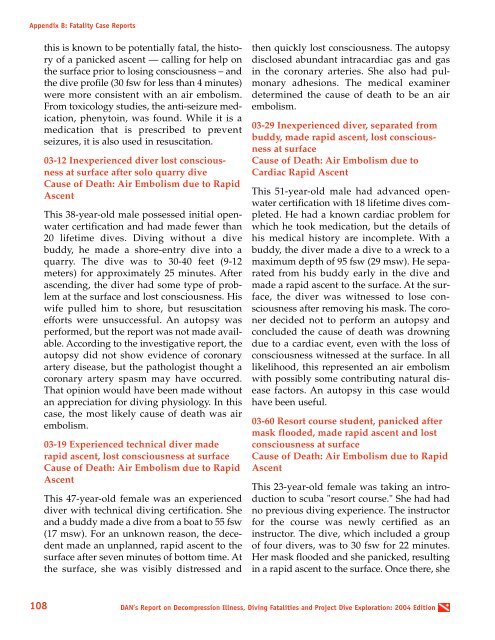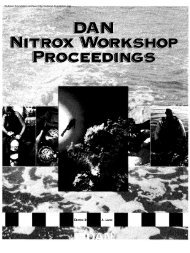Report on Decompression Illness, Diving Fatalities and Project Dive
Report on Decompression Illness, Diving Fatalities and Project Dive
Report on Decompression Illness, Diving Fatalities and Project Dive
- No tags were found...
Create successful ePaper yourself
Turn your PDF publications into a flip-book with our unique Google optimized e-Paper software.
Appendix B: Fatality Case <str<strong>on</strong>g>Report</str<strong>on</strong>g>sthis is known to be potentially fatal, the historyof a panicked ascent — calling for help <strong>on</strong>the surface prior to losing c<strong>on</strong>sciousness – <strong>and</strong>the dive profile (30 fsw for less than 4 minutes)were more c<strong>on</strong>sistent with an air embolism.From toxicology studies, the anti-seizure medicati<strong>on</strong>,phenytoin, was found. While it is amedicati<strong>on</strong> that is prescribed to pre v e n tseizures, it is also used in resuscitati<strong>on</strong>.03-12 Inexperienced diver lost c<strong>on</strong>sciousnessat surface after solo quarry diveCause of Death: Air Embolism due to RapidAscentThis 38-year-old male possessed initial openwatercertificati<strong>on</strong> <strong>and</strong> had made fewer than20 lifetime dives. <strong>Diving</strong> without a divebuddy, he made a shore-entry dive into aq u a r r y. The dive was to 30-40 feet (9-12meters) for approximately 25 minutes. Afterascending, the diver had some type of problemat the surface <strong>and</strong> lost c<strong>on</strong>sciousness. Hiswife pulled him to shore, but resuscitati<strong>on</strong>efforts were unsuccessful. An autopsy wasperformed, but the report was not made available.According to the investigative report, theautopsy did not show evidence of cor<strong>on</strong>aryartery disease, but the pathologist thought acor<strong>on</strong>ary artery spasm may have occurred.That opini<strong>on</strong> would have been made withoutan appreciati<strong>on</strong> for diving physiology. In thiscase, the most likely cause of death was airembolism.03-19 Experienced technical diver maderapid ascent, lost c<strong>on</strong>sciousness at surfaceCause of Death: Air Embolism due to RapidAscentThis 47-year-old female was an experienceddiver with technical diving certificati<strong>on</strong>. She<strong>and</strong> a buddy made a dive from a boat to 55 fsw(17 msw). For an unknown reas<strong>on</strong>, the decedentmade an unplanned, rapid ascent to thesurface after seven minutes of bottom time. Atthe surface, she was visibly distressed <strong>and</strong>then quickly lost c<strong>on</strong>sciousness. The autopsydisclosed abundant intracardiac gas <strong>and</strong> gasin the cor<strong>on</strong>ary arteries. She also had pulm<strong>on</strong>aryadhesi<strong>on</strong>s. The medical examinerdetermined the cause of death to be an airembolism.03-29 Inexperienced diver, separated frombuddy, made rapid ascent, lost c<strong>on</strong>sciousnessat surfaceCause of Death: Air Embolism due toCardiac Rapid AscentThis 51-year-old male had advanced openwatercertificati<strong>on</strong> with 18 lifetime dives completed.He had a known cardiac problem forwhich he took medicati<strong>on</strong>, but the details ofhis medical history are incomplete. With abuddy, the diver made a dive to a wreck to amaximum depth of 95 fsw (29 msw). He separatedfrom his buddy early in the dive <strong>and</strong>made a rapid ascent to the surface. At the surface,the diver was witnessed to lose c<strong>on</strong>sciousnessafter removing his mask. The cor<strong>on</strong>erdecided not to perform an autopsy <strong>and</strong>c<strong>on</strong>cluded the cause of death was drowningdue to a cardiac event, even with the loss ofc<strong>on</strong>sciousness witnessed at the surface. In alllikelihood, this represented an air embolismwith possibly some c<strong>on</strong>tributing natural diseasefactors. An autopsy in this case wouldhave been useful.03-60 Resort course student, panicked aftermask flooded, made rapid ascent <strong>and</strong> lostc<strong>on</strong>sciousness at surfaceCause of Death: Air Embolism due to RapidAscentThis 23-year-old female was taking an introducti<strong>on</strong>to scuba "resort course." She had hadno previous diving experience. The instructorfor the course was newly certified as aninstructor. The dive, which included a groupof four divers, was to 30 fsw for 22 minutes.Her mask flooded <strong>and</strong> she panicked, resultingin a rapid ascent to the surface. Once there, she108DAN’s <str<strong>on</strong>g>Report</str<strong>on</strong>g> <strong>on</strong> Decompressi<strong>on</strong> <strong>Illness</strong>, <strong>Diving</strong> <strong>Fatalities</strong> <strong>and</strong> <strong>Project</strong> <strong>Dive</strong> Explorati<strong>on</strong>: 2004 Editi<strong>on</strong>
















